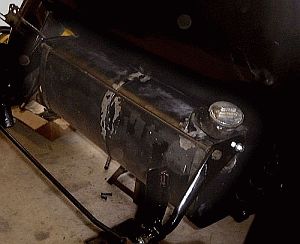|
Petroleum is the name given to the liquid also known as
"crude oil" pumped out of the ground. This black-brown liquid contains
aliphatic hydrocarbons, or molecules composed of nothing but hydrogen and
carbon. The carbon and hydrogen atoms link together in complex molecules or
"chains" of different lengths where the length is determined by the number
of carbon atoms present in the molecule. A single carbon atom with four
hydrogen atoms attached to it is the simplest molecule or chain. Known as
methane (CH4), this gas so light that it floats like helium. As
carbon and hydrogen atoms are added, the chains get longer and take on
different properties and characteristics.
The first four chains -- CH4 (methane), C2H6
(ethane), C3H8 (propane) and C4H10
(butane) -- are all gases, and they boil at -161, -88, -46 and -1 degrees F,
respectively (-107, -67, -43 and -18 degrees C). The molecular chains up
through C18H32 are all liquids at room temperature,
and the chains above C19 are all solids at room temperature.
Each of the different molecules,
depending on their chain length, has a progressively higher boiling point.
This means that each can be derived from crude oil by boiling the crude oil
and separating out each molecule by distillation of the vapors that are
emitted by the boiling crude oil. This is what happens in an oil refinery.
Crude oil is heated and the vaporization temperature of each petroleum-based
product can be distilled out into its gaseous, liquid, or solid state.
The crude oil chains in the C5,
C6 and C7 range are all very light, easily vaporized,
clear liquids called naphthas. The naphtha product family is used as
solvents, as fluids in dry cleaning, as well as paint solvents and other
quick-drying products. Included in this family are alcohols, mineral
spirits, lacquer thinners and similar materials.
The next major grouping is the fuel
family.
Refined to meet a particular need, fuel oils are mixtures of aliphatic (open
chain and cyclic compounds) and aromatic (compounds similar to benzene)
petroleum hydrocarbons. In addition, they may contain small amounts of
nitrogen, sulfur, and other elements as additives.
The chains from C7H16 through C11H24
are blended together and used as gasolines. Members of the the
gasoline group vaporize at temperatures below to near the boiling point of
water. That's why gasoline evaporates. Kerosene is another member of
the fuel family with molecular chains in the C12 to C15
range. Kerosene will eventually evaporate but takes a long time to do so.
Along with kerosene are the diesel and aviation fuels. This group also
includes the heavier fuel oils (like heating oil for houses).
Primarily their boiling
point ranges, chemical additives, and uses distinguish each of the blends
from other members of the fuel oil family. All fuel oils are liquids
at room temperature, although they can evaporate. The rates at which
various fuel oils evaporate is dependent on the temperature and the
composition of the individual fuel oil. Most fuel oils are yellowish
to light brown in color and generally have a kerosene-like odor, are
flammable, and burn at temperatures between 177 °C and 329 °C.
After the kerosene family are the
lubricating oils. These oils no longer vaporize at normal temperatures but
need to be heated to a high temperature to vaporize. For example, engine oil
can run all day at 250 degrees F (121 degrees C) without vaporizing at all.
Oils go from very light (like 3-in-1 Oil) through various thicknesses
of motor oil. There are also the steam cylinder oils and the thick gear oils
in the lubrication class. The final members of the lubrication group are the
semi-solid greases. Molecular chains above the C20 range are
generally solids. This molecular group starts with paraffin wax, then moves
into the tars and asphaltic bitumens that are used to make asphalt roads.
All of these different substances come from crude oil with the only
difference being the length of the carbon chains.
Just as a can of "regular" soft drink
has more calories than a can of "diet" soft drink, so too does a gallon of
diesel or kerosene fuel have more Btus than a gallon of ethanol fuel, methanol fuel,
liquefied petroleum gas, liquefied natural gas, compressed natural gas, or
hydrogen (these are different types of clean alternative fuels).
An advantage of kerosene as a fuel
is that is provides about 12% more heat per gallon as compared to gasoline.
More heat means more steam and faster steaming per gallon of fuel carried by
the car.
The energy content of a gallon of
gasoline ranges from about 109,000 to 125,000 BTU (British Thermal Units).
The average is about 114,000 BTU. The energy content of kerosene is between
about 128,000 and 130,000 BTU per gallon. Thus kerosene has a lower
heating value rating than gasoline as less liquid fuel is required to obtain
a given amount of heat energy. The heating value of a fuel is defined
as the total heat in BTUs obtained from combustion of a specified amount of
fuel and its stoichiometrically correct amount of air, both being at 60°F
when combustion starts, and the combustion products being cooled to 60°F
before heat release is measured. |
